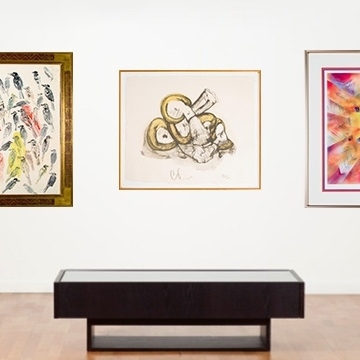

5 Things You Didn’t Know About How to Frame Art
So you’ve selected a great piece of art that will accent your home or office, but what about the frame? Our Senior Curator, Brittany Gersh, gives us five insider tips on hanging your framed art to complement its aesthetic and preserve its resale value.
1. Splurge on a mat, save on the frame.

A mat serves as a buffer between this Picasso print and its frame.
“There are a couple of different ways to hang a piece,” says Gersh. “It depends on what you’re trying to accomplish.” If you are looking to save on framing, but still want to protect and preserve your art, Gersh recommends “getting a cheap frame and then swapping out the mat and doing it that way. Just make sure the mat is archival. An archival mat is made of acid-free materials. It won’t degrade the piece of art that it’s touching. A lot of mats are low-quality and will contribute to degradation over time. It’s important to know the materials touching your piece are high-quality.”
2. Pick the right hardware.
Most frames will have wires, D-rings, or both on the back of the frame. “If you’re in an apartment or temporary space, it’s easier to hang framed art this way,” says Gersh. For a more permanent installation, “go with cleats, which are beveled pieces of wood that fit flush against the wall. It depends on your walls, where you’re putting your art and what the piece is, but especially in places like California where earthquakes are common, cleats are the most secure. It’s unlikely that your piece will fall off by accident. In my opinion, they’re the safest and most attractive way to hang a piece.”
3. Choose a faceplate.

Andy Warhol, Hammer and Sickle under Plexiglas.
There are a few different ways to choose a faceplate (the glass that functions to protect a work of art). This element is relatively dependent on the work itself. “If a piece is a painting,” Gersh tells us, “faceplates can often be distracting, because they don’t allow you to see the texture and brush strokes.” However, if you have a print, photograph, work on paper, or a piece with sensitive surfaces, a faceplate is necessary. A few options Gersh lists include “glass, Plexiglas, museum glass, or UV Plexiglas.” Museum glass has no glare or reflection, and gives the work of art the clearest look. Everything else, Gersh says, has a bit of tint to it. “Plexi has a yellow cast, glass can have a green cast. Whatever you choose will have an affect on the way your piece looks overall. Museum glass is the purest faceplate you can get, but it’s glass, so by nature it’s fragile.” If you’re looking for something a little more durable, Gersh recommends Plexiglas: “I’ve moved so much that I don’t want to have to worry about it breaking!”
4. Consider scale.

Susan Morelock, Lakes XII, 2010, framed by the artist.
A frame should be scaled appropriately to complement rather than overpower the piece it encases.”It all comes down to personal preference,” Gersh insists, “but in general, for bigger pieces, you want bigger frames. Some artists create frames themselves, which then become intrinsic to the work itself.” There are a few faux pas to avoid, such as choosing a frame that distracts from a piece. “The best frames I’ve seen are virtually unnoticeable, until you get up close,” says Gersh. “If the sides of the painting are interesting, you might want the frame to highlight those features. It’s all about showcasing the work.”
5. Focus on preservation.

Repurposed Art Deco frame encasing a Frank Horvat photograph.






